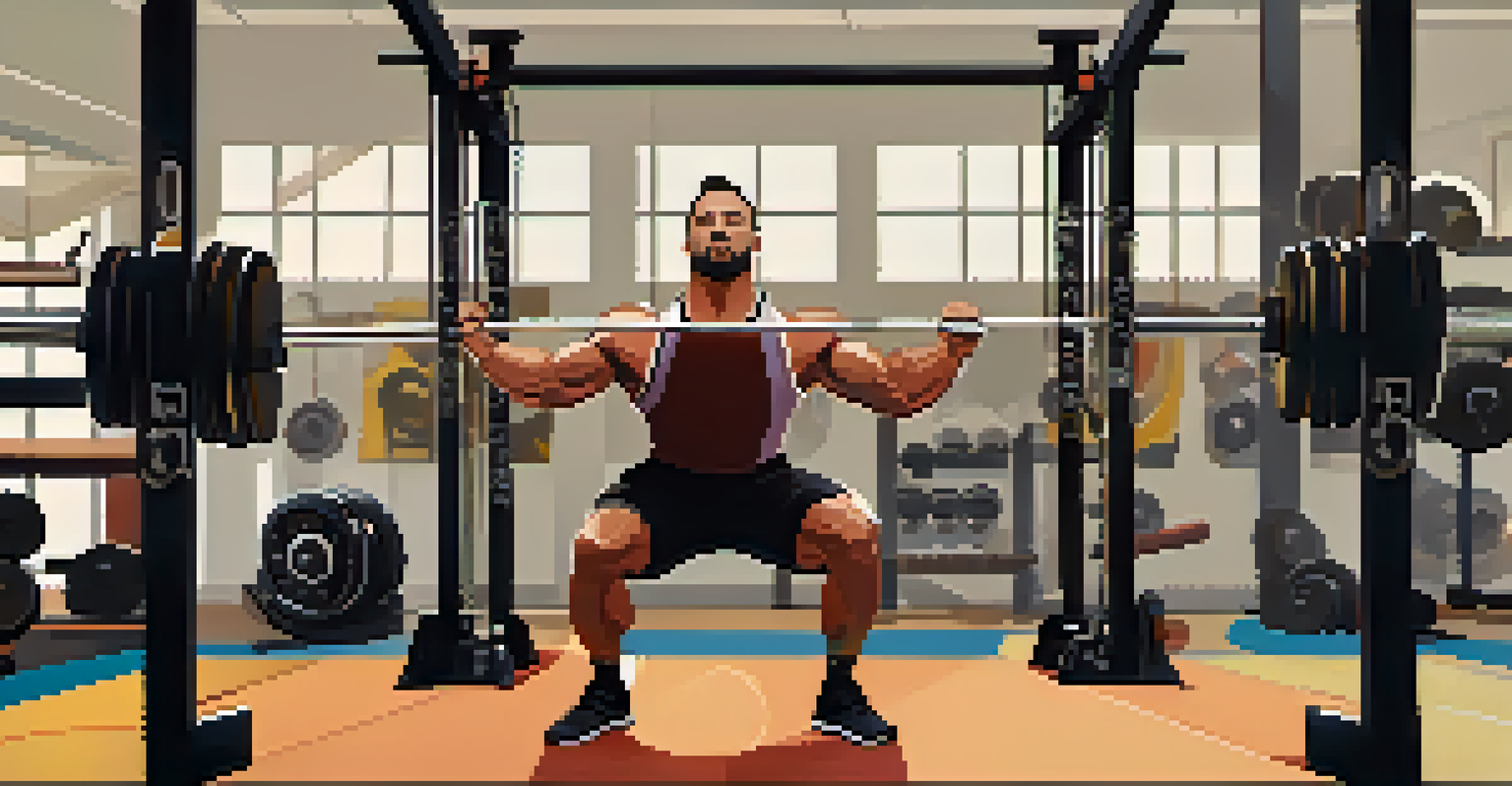Injury Prevention: Using Powerlifting to Build Resilience

Understanding the Importance of Injury Prevention
Injury prevention is a crucial aspect of any fitness regimen. It’s not just about lifting weights; it’s about lifting weights safely. When we think of injuries, we often imagine the immediate pain, but the long-term implications can be even more damaging. By proactively addressing potential risks, we can ensure a sustainable fitness journey.
The body achieves what the mind believes.
Powerlifting, which focuses on three main lifts—squat, bench press, and deadlift—offers a structured approach to building strength. This structure allows for a progressive overload that not only enhances muscle growth but also fortifies the joints and connective tissues. A well-executed powerlifting program can help in identifying weaknesses before they lead to injury.
Moreover, cultivating awareness of our bodies through powerlifting can lead to better movement patterns in everyday life. This understanding is key to preventing injuries, as it enables us to lift and move safely, whether in the gym or while performing daily tasks. In essence, injury prevention becomes an integrated part of our lifestyle.
The Role of Strength Training in Resilience
Strength training, particularly through powerlifting, builds resilience in our muscles and bones. As we lift heavier weights over time, we stimulate muscle fibers, which adapt and grow stronger. This adaptation not only enhances our physical capabilities but also prepares our bodies to handle unexpected stresses.

Additionally, stronger muscles support our joints, reducing the risk of injuries. For instance, well-developed leg muscles can help protect the knees during high-impact activities. When our muscles are strong, they act as natural shock absorbers, helping to cushion our bodies from the strain of daily movements.
Injury Prevention is Essential
Proactively addressing potential risks ensures a sustainable fitness journey.
Beyond physical strength, powerlifting fosters mental resilience. The discipline required to train consistently and the determination to overcome challenges in lifting can translate into a stronger mindset. This mental toughness is invaluable, especially when facing setbacks or injuries, as it empowers us to stay committed to our recovery and training goals.
Proper Technique: The Foundation of Injury Prevention
When it comes to powerlifting, mastering proper technique is non-negotiable. Using correct form ensures that the right muscles are engaged and reduces undue stress on joints. For example, a poorly executed squat can lead to back or knee injuries, undermining all the hard work put into strength training.
Strength does not come from physical capacity. It comes from an indomitable will.
To cultivate proper technique, it’s beneficial to work with a coach or experienced lifter. They can provide feedback and help identify any flaws in your form. Additionally, using video analysis can be a game-changer—it allows you to visually assess your lifts and make necessary adjustments for improvement.
Consistency in practicing good form not only enhances performance but also instills a sense of safety during lifts. As you become more confident in your technique, you’ll find that you can push your limits safely, further building your resilience against injuries.
Incorporating Mobility and Flexibility Training
Mobility and flexibility play a vital role in preventing injuries, especially for powerlifters. While lifting heavy weights is essential for building strength, it’s equally important to ensure that your joints have the range of motion they need to function properly. Including mobility exercises in your training routine can help achieve this balance.
Dynamic stretches before workouts prepare your body for the demands of lifting, while static stretches post-workout can aid in recovery. For example, incorporating hip openers can enhance your squatting technique and ensure your hips are adequately prepared for the load. This not only improves performance but also mitigates the risk of injury.
Strength Training Builds Resilience
Powerlifting enhances physical and mental resilience, preparing the body for unexpected stresses.
Furthermore, flexibility training helps to alleviate muscle tightness, which can lead to improper lifting mechanics. By committing to a regimen that includes both powerlifting and flexibility work, you’ll develop a more resilient body, capable of handling heavier weights and more intense workouts.
Listening to Your Body: Recognizing Fatigue and Pain
One of the most critical aspects of injury prevention is learning to listen to your body. Fatigue and pain are signals that should never be ignored. While pushing through discomfort can sometimes be a part of growth, understanding the difference between good discomfort and potential injury is essential for long-term success.
For example, if you notice a sharp pain in your shoulder during bench presses, it may be a sign that you need to adjust your technique or take a break. Ignoring these signals can lead to more severe injuries down the road, sidelining you from your training. Instead, recognize these cues as opportunities to modify your approach.
Taking rest days seriously is another vital component of this process. Recovery is when your muscles repair and grow stronger. By prioritizing rest and recovery, you not only enhance your resilience but also ensure that your body is prepared for future challenges.
The Importance of Warm-Up and Cool-Down Routines
A proper warm-up and cool-down routine is a fundamental part of any powerlifting program, especially when it comes to injury prevention. Warming up prepares your muscles and joints for the heavy lifting ahead, increasing blood flow and reducing the risk of strains. Think of it as priming an engine before a race—it ensures everything is running smoothly.
Dynamic movements, such as leg swings and arm circles, can effectively activate the muscles you'll be using during your lifts. This preparation not only enhances performance but also sets a positive tone for your workout. On the flip side, cooling down helps your body transition back to a resting state, which is crucial for recovery.
Listen to Your Body's Signals
Recognizing fatigue and pain is crucial for modifying your approach and preventing long-term injuries.
Incorporating stretching and mobility exercises during your cool-down can further aid in reducing muscle soreness. This practice not only contributes to injury prevention but also helps maintain flexibility over time. A consistent warm-up and cool-down routine lays the foundation for a successful powerlifting journey.
Building a Support System for Your Powerlifting Journey
Having a strong support system can significantly enhance your powerlifting experience and injury prevention efforts. Surrounding yourself with like-minded individuals who share your goals creates a motivating environment. Whether it’s a lifting partner, a coach, or a supportive community, these connections can make all the difference.
Sharing your challenges and victories with others can provide accountability and encouragement. For instance, if you’re feeling fatigued or are struggling with a particular lift, discussing it with a training partner can offer new insights or solutions. This collaborative approach fosters resilience not just physically, but mentally as well.

Additionally, learning from others’ experiences—especially in terms of injury prevention—can help you avoid common pitfalls. Engaging in discussions about techniques, recovery strategies, and training philosophies can enrich your own approach to powerlifting, ultimately guiding you towards a healthier and more sustainable lifting journey.